The Divine LuteChris Goodwin, "About the Lute," The Lute Society, accessed November 23, 2023.
Now divine aire, now is hi soule ravisht, is it not strange that sheepes guts should hale soules out of mens bodies?
William Shakespeare, Much Ado about Nothing
William Shakespeare (1564–1616) was only one of many writers of his day who attributed to the lute the power to transport the listener into a kind of ecstasy; for throughout the Renaissance the lute's ravishing tone made it the most esteemed and admired of all musical instruments. The fame of the greatest players spread through all Europe, and the doors of royal courts and palaces were open to them (a number were consequently employed as spies) while instruments by the most famous makers could fetch astronomical sums.
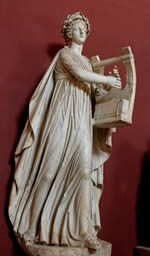
It is not hard to see the appeal of the instrument. Light and portable, a harmonizing instrument far cheaper and easier to maintain than keyboards, it was (and is) enormously versatile; it was used to play dance music, popular tunes, arrangements of vocal music and song accompaniments, and soon generated a solo repertoire of its own, in the form of preludes, passemezzi (a sort of Renaissance twelve-bar blues) and the most refined and expressive fantasias. It was seen as the heir of the ancient Roman cithara (fig. 1) or lira, which gave it a further boost in an age obsessed with Classical literature. Above all, it was the lute's ravishing sound which made it so admired.
Over its long history a truly enormous repertoire was created for the instrument. American scholar Arthur Ness has estimated that 25,000 pieces survive for the Renaissance lute, and probably as many for the Baroque instruments—and that is only the music specially notated in lute tablature, not counting music from the Mediaeval and Baroque eras which is written in normal staff notation.
The "Painter's" LuteInformation provided by Lynda Sayce, lutenist and expert in lute, archlute, and theorbo history.

Michael Praetorius,
Syntagma musicum II
1618–19
The lute's seductive appeal, combined with the challenge of depicting it correctly, was as strong among Dutch painters as it had been for previous generations of European painters. Examination of Dutch genre works in particular show that a number of painters clearly kept it as a studio prop and, naturally, a few (certainly Jan Steen 1626–1679) must have actually played it. In some cases, the same artist featured the same lute in several paintings. Lutes, or even theorbos appear as part of studio furniture in self portraits as well. For example, in Michael Sweerts (1618–1664)' An Artist's Studio (fig. 2), a lovely Italian theorbo lies propped in one corner.

Michiel Sweerts
1652
Oil on canvas, 73.5 x : 58.8 cm.
Detroit Institute of Arts, Detroit
The lute, other than being a continual source of iconographical inspiration, was frequently used as a training ground for learning the intricacies of linear perspective (fig. 3). There exist many sixteenth-century engravings which show the lute being drawn, usually in the difficult three-quarter or end-on perspective views (the full face view of the soundboard is relatively straightforward to draw). The lute was also an important ingredient in vanitas painting which represented the transient nature of life. At times, the ephemeral nature of heard music was conveyed in an even more graphic manner via a broken string or two, or the instrument portrayed face down with obvious finger marks in heavy dust, on its normally glossy back (fig. 4).

Lorenzo Sirigatti
1596
Venice, Girolamo Franceschi

Evaristo Baschenis
c. 1660
Oil on canvas
95.5 x 129 cm.
The Barber Institute of Fine Arts, Birmingham
The Lute in Vermeer's Paintings
Under the influence of the successful young Leiden painter Frans van Mieris (1635–1681), Vermeer frequently chose the theme of a young woman playing a musical instrument, alone in a room. Vermeer painted the lute two times, once in the Woman with a Lute (fig. 5) and another time in the late Concert (fig. 6). At first glance, other stringed-instruments which appear in his works might be mistaken for the lute. In reality, they are citterns, a close relative of the lute. Only in Woman with a Lute did Vermeer portray the lute in a prominent position. Unfortunately, due to the poor state of conservation of this picture, none of its details, which were so lovingly portrayed by a host of Dutch painters, can be made out. All indications of the instrument's strings or have entirely disappeared and the delicately carved ornamental soundhole fretshas been reduced to a few unintelligible smudges of paint.

Johannes Vermeer
c. 1662–1665
Oil on canvas, 51.4 x 45.7 cm.
Metropolitan Museum of Art, New York
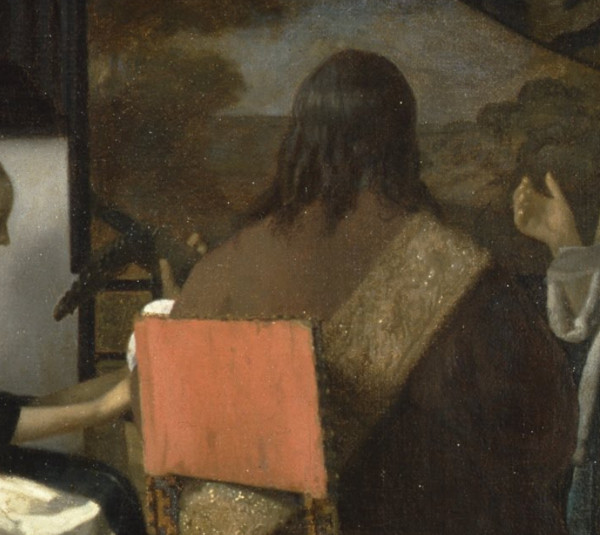
Johannes Vermeer
c. 1663–1666
Oil on canvas, 72.5 x 64.7 cm.
Isabella Stewart Gardner Museum, Boston
As the player sits with his back to the viewer, only the instrument's tuning head is visible. This is bent back from the neck nearly a right angle, so it is evident that the man is playing a lute.
Despite the poor condition of the painting, lute expert Lynda Sayce notes that the projecting peg for the treble string (in its little rider) of the lute in the Woman with a Lute most likely indicates an instrument with ten or eleven courses. An eleven-course lute would be the expected type for the date, but if the lute was a studio prop owned by the painter, it might be rather out of date. The exact number of strings cannot be counted and thus it is not possible to determine if it is a 10 or 11 course instrument. "Perhaps the young woman with the dreamy expression on her face is awaiting the return of a suitor from a journey. The map may allude to such a circumstance. Or is her self-forgetting attention devoted solely to the sounds emerging from her instrument?"Peter Forster, Visitors' Guide to the exhibition Senses and Sins / "Der Zauber des Alltäglichen," Rotterdam, Frankfurt, 2005. In fact, it should be noted that the young lady is not actually playing the lute, she is tuning it. Since it was a well-known fact that the lute goes out of tune often, it may be that it had subtle bearing on the meaning of the painting, which was evident to contemporary observers. The open books lying before her on the covered table are presumably lute songbooks which had been published in incredible numbers not only in the Netherlands but throughout Europe as well. A sense of longing, of something incomplete, pervades the mood of the whole painting subtly "in tune" with the lute's delicate tone.
The young lady tuning the lute
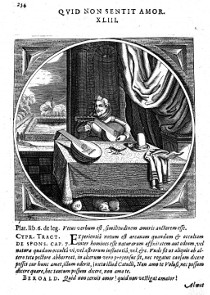
from Jacob Cats, Proteus
The young lady in Vermeer's painting is not in reality playing her instrument but rather tuning it. The lute goes out of tune easily and it is tedious if not difficult to tune. Thus lutenists share a joke "We spend half our time tuning, and the other half playing out of tune."
Vermeer has not given a precise explanation for the woman's meditative attitude, preferring instead to suggest a mood that has universal resonances. However, he provided two indications that the woman's musing revolves around a distant lover: the map of Europe, which may well allude to foreign travels; and the bass viol, dimly visible under the table. The presence of this second instrument relates a specific emblem by Jacob Cats (1577–1660), which describes metaphorically how the resonance of the strings of one musical instrument are felt in another, just as the heartstrings of two lovers sound as one, even when they are separated.
The Concert, instead, shows the rear view of part of what we now call the twelve-course double-headed lute, which is the archetypal lute of the seventeenth-century Dutch painters. Here, the painting's thematic content is quite different. The air of perfect calm and spiritual harmony is intensified by the two Arcadian landscapes portrayed, one in an ebony frame, and the other on the harpsichord's opened lid. Vermeer did his best to sustain the painting's sense of thematic harmony by establishing a well-proportioned composition in which each compositional element is meticulously balanced against another.
History
The name and form of the European lute derives from its early ancestor, the Arab "al 'Ūd" which literally means wood, most likely because the instrument was almost entirely made of various kinds of wood.
The first depictions of the lute's ancestors were found in the former Mesopotamia and Asia Minor (c. 2nd millennium B.C.), later in Egypt. The short-necked lute appeared at first as the P'i-p'a (Biwa) in East Asia (China, fifth century A.C.) and as the Ūd in Arabia (7th-8th century). It was brought to the Iberian Peninsula (8–9th century) probably by the Moors, and later (c. 1100) to Sicily by the Saracens. The form of the European lute with the turned back pegbox as a substantial characteristic (presumably to help hold the low-tension strings firmly against the nut) had been developed in Spain during the thirteenth century. By the fourteenth century the lute was widespread throughout Italy and had made significant inroads into the German-speaking areas.
The lute really came into its own in the late fifteenth century. At first, it had been employed to accompany the singing voice, but with the appearance of the great lutenists and composers (Vincenzo Capirola, John Dowland, Thomas Mace, Valentin Bakfark, Alessandro Piccinini or Nicolaes Vallet) and the publication of numerous lutebooks, it was also used as a solo instrument since musicians found that it could be played with fingertips as well as with a quill.
"Lutes continued to evolved at the end of the Renaissance and into the Baroque period. At the end of the seventeenth century, in France, the lute regained popularity as an instrument ideal to accompany vocal music as well as a soloist in court performances. This spurred a new series of modifications, including a completely new way of tuning the strings, and the addition of an 11th course. In the first decades of the eighteenth century, lute music was revolutionized in Germany by lute player and composer Silvius Leopold Weiss (1687–1750). His musical ideas made it necessary to extend the number of strings, giving birth to the thirteen-course lute. To meet these new standards, most of the old instruments were modified by changing the bridge and adding small protruding extensions, called riders, to the pegbox. Another type of thirteen–course instrument, the swan-neck lute, developed simultaneously; it utilized an extended pegbox, often of a swooping shape, to accommodate additional bass strings. As lutes continued to acquire supplementary strings, they became more difficult to tune and maintain. These hindrances, along with the rising popularity of violins and keyboards, pushed the lute almost to extinction. The second half of the eighteenth century saw the decay of the lute. An important number of old lutes were transformed into guitars by narrowing the neck, adding metal or bone fixed frets, and replacing the bridge and pegbox to allow only six single strings."Jonathan Santa Maria Bouquet, "The Lute," in Heilbrunn Timeline of Art History (New York: The Metropolitan Museum of Art, 2000), accessed November 23, 2023.
With the introduction of the harpsichord (and later the piano) and the larger orchestra, the lute, with its soft voice, gradually fell out of favor and it disappeared from the musical stage for two hundred years. Thanks to the early music movement of the last decades, the lute has enjoyed a modern revival. Increasing interest in practical performance and research have given birth to national lute societies and international lute symposiums. Following the early music craze of the 1970s and the recordings of Julian Bream the standards of both making and playing are now high. Today, lute players and makers approach the lute and its music from an academic standpoint, and lute making has become a cottage industry throughout the world.
Structure
The Western lute, as it is traceable from the Renaissance time, has a rounded body that could best be described as being the shape of a longitudinally sliced half pear. Its vaulted back is made up of a number of separate ribs of wood (maple or yew as local woods, later rosewood, sycamore, cedar, or cypress), bent over a mould and glued together edge to edge to form the deep rounded body. These ribs are often no more than one-thirty-second of an inch in thickness. Wooden bars are glued underneath the belly to strengthen it and add to the resonance.
The neck is made of hardwood (sycamore or maple), later very often veneered with decorative hardwood like ebony, or even inlaid with strips of ivory. The fingerboard is fretted by means of tying gut around the neck at the appropriate places. Visually, the lute is easily recognizable because of its characteristically angled pegbox.
Although the greatest repertoire for the lute is from England, the best makers were Germans who lived in Italy. The delicacy and expressiveness of Renaissance lute music is mirrored in the light construction of the instrument. Stringing is light since the body is not able to withstand twelve or more strings at high tension.Chris Goodwin, "About the Lute," The Lute Society, accessed November 23, 2023.
At the back of the top end of the neck the housing for the pegbox is cut out, with the slender tapering hardwood tuning-pegs inserted from the sides. After about 1595, various branches of the lute family developed different and characteristic pegbox forms in order to accommodate the longer bass strings needed to extend its lower tonal range.
From c. 1580 onwards, almost all surviving lutes have separate ebony fingerboards, set flush with the soundboard and usually with separate "points" decorating the joint between the fingerboard and soundboard.
The soundboard is a flat thin plate of softwood, often made from two halves joined along the Centrex line. Several pieces were used for larger instruments. An ornamental soundhole—the "rose"—is carved into the soundboard, a few rare instruments may have several small roses.
The rose centers of seventeenth-century lutes were as much a testament to the luthier's craftsmanship as they were essential to the instrument's acoustical properties. Crafted meticulously from the same softwoods as the soundboard, typically spruce, the rose or rosette was a focal point of the lute's design. These ornate carvings, often intricate floral or geometric patterns, were either skillfully carved directly into the soundboard or made separately and then inlaid.
Functionally, the rose played a critical role in shaping the lute's sound. It facilitated the distribution and modulation of sound produced by the vibrating strings, influencing the tonal characteristics of the instrument. The design and execution of the rose were therefore not just aesthetic choices but deliberate acoustical considerations.
Beyond their functional and decorative roles, these roses often bore symbolic significance. They could represent the luthier’s workshop, their region, or carry other personal or symbolic messages. The style and complexity of these designs varied widely, reflecting regional preferences and the evolving artistic trends of the time.Additionally, the rose provided a degree of protection to the soundboard’s central area, which, due to its thinness, was particularly vulnerable to damage.
The bridge underwent a rather slow evolution. It was consistently made of a light hardwood (pear, plum or walnut), sometimes stained black, and was glued directly to the surface of the soundboard. Its cross-sectional design was cleverly arranged to minimize stress at the junction with the thin and flexible soundboard. Holes drilled through the bridge took the strings, which were tied so that they were supported by a loop of the same string rather than by a saddle as in the modern guitar. This has a remarkable effect on the tone and contributes to the sweetness of the lute's sound.
The "gut" strings used in early stringed instruments, are made from animal intestines, predominantly sheep. Their manufacturing is labor-intensive, involving cleaning, twisting, and drying the intestines to form strings. They are cherished for their warm, rich tonal qualities, which differ significantly from modern steel or synthetic strings, offering a more organic sound ideal for historical music performances. However, gut strings have lower tension than modern strings, requiring frequent tuning and are less durable, being sensitive to humidity and temperature changes. The development of wound gut strings, which feature a gut core wrapped in metal wire, expanded the tonal range of instruments. While less durable and requiring more maintenance than modern strings, gut strings are still used today, mainly in historically informed performances, due to their unique sound and historical authenticity.
The strings of the lute are arranged in pairs—the courses, being tuned either in unison or at the octave. The highest-pitched course, called the "chantrelle" (from French singer) usually consists of only a single string and is the first course in the count. Thus an eight-course lute usually has fifteen strings. Medieval lutes had at first four, later five courses. In the last decades of the Renaissance the number of courses grew to six or even more courses. Together with the various kinds of tuning it might be comprehensible that the tuning of a lute takes some time, apart from the fact that the natural material the lute is made of, is very sensitive to the changing climate of the room.
Technique
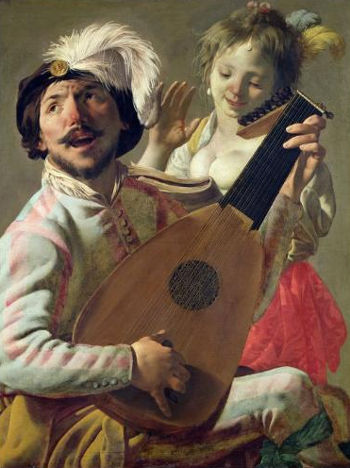
Hendrick ter Brugghen
c. 1628
Oil on canvas, 101 x 81 cm.
Musée du Louvre, Paris
This picture shows a 'thumb out' right hand position
on a 10-course lute.
As in painting, the training of professional lute players took place in a system of apprenticeship. Thus, there exist few written instructions specifically regarding playing technique. The more conscientious authors lamented the "extreme Shie of many masters in revealing the Occult and Hidden Secrets of the Lute" (Thomas Mace). Among the notable authors of instruction books were Vincenzo Capirola (resp. one of his pupils of Venice who prepared the lavishly illuminated Capirola Lutebook, 1517), John Dowland (c. 1563–1626), Thomas Mace (1612/1613– c. 1706) (Musick's Monument, 1676, a complete handbook for the lute) and the German Hans Judenkünig (1450–1526) who first codified a system of fingering for the left hand. Plucking is done with the soft part of the fingers and thumb (fig. 7), not the nails. The best lute players use little motion of either hand.
In the Middle Ages, lute players plucked the strings with a strong quill and played principally accompanying chords to their songs. With the development of the polyphony during the Renaissance period, lutenists began to pluck the strings with the thumb (for the bass, playing downwards, for accenting beats) and the following three fingers (playing upwards, for the unaccented beats). The little finger had to be placed on the belly to support the hand. According to the Capirola manuscript (the first with instructions for the right hand), the thumb was held under the second finger, that is, inside the hand. With the increasing number of the courses, a new position and movement of the right hand became necessary; the hand had to be turned so that the fingers could touch the strings almost in a right angle. The thumb gained a greater stretch to reach all the bass courses. This "thumb-out position" was of advantage for the lively bass lines in the new compositions. Many other, often difficult techniques both for the right and the left hand had been developed to extend the resources of the instrument and to meet the musical "fashion" of the time.
Various Kinds of Lutes
Due to the lute's popularity in the Renaissance, further structural developments of this instrument extended its tonal capabilities. "Music demanded additional low notes in order to play thorough bass. The new function of the lute as a continuo instrument prompted the need for longer bass strings, generating a number of experimental lutes. First to appear, without success, were instruments with small necks and enormous bodies; shortly after, lute makers built instruments with extensions on the neck and/or pegbox. This led to a variety of additions to the lute family, including archlutes, double-headed lutes, and theorbos. Silver wound strings, invented around the 1660s, enabled lutes to reach deeper and stronger bass notes with shorter strings. These strings with new technology replaced the lower gut strings and put an end to the ever increasing length of the lute."Jonathan Santa Maria Bouquet, "The Lute," in Heilbrunn Timeline of Art History (New York: The Metropolitan Museum of Art, 2000), accessed November 23, 2023.
One of the most popular of the new instruments, which still appears in early music concerts or performances of early Italian operas (Monteverdi, 1567–1643)ù), is the theorbo (in Italy also called "chitarrone"). The theorbo was probably invented in Florence in the sixteenth century as it was first mentioned in a description of the Medici wedding celebration in 1589.
In Michael Praetorius's (1571–1621) Syntagma musicum we find two types of a theorbo (fig. 8). The theorbo was developed by adapting a bass lute to a tenor lute. In addition to the strings which are stopped by the fingers on a fretted fingerboard, the theorbo has a separate nut and pegbox for a set of longer, unstopped bass strings (diapasons).
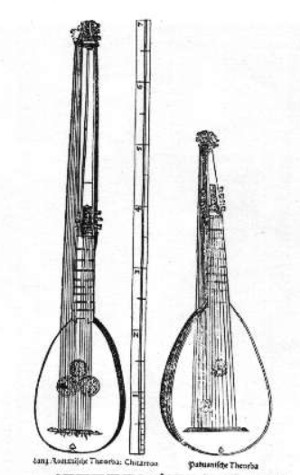
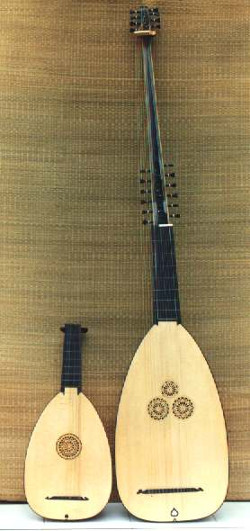
Beyond the upper end of the first pegbox (for the stopped strings) the neck extends to a second pegbox for the additional bass strings. The extension is of the same piece of wood as the first pegbox, and the bass strings are kept from crossing the stopped courses by setting the extensions at a slight angle off centre. As the bass strings cannot be stopped (the fingers of the left hand would not reach them without problems) they are tuned to a scale and are played by the plucking right hand. So the theorbo has normally fourteen courses: six double for the stopped strings and eight for the single bass strings. The extended neck is necessary because, before the invention of wire-wound strings, increasing the length was the only way to obtain a clear and sustained sound from low bass strings, sometimes ninety centimeters and longer. Some surviving instruments are around two meters long! The image to the right shows an excellent comparison between a "normal" lute and a theorbo.
The stopped courses of the theorbo are much longer than those of the ordinary tenor lute and need a different tuning. The first course, and usually the second, was tuned down an octave, so that the third course was then the highest and became the melody course. This is the so-called "re-entrant-tuning."
During the seventeenth and part of the eighteenth centuries the theorbo was very popular as an accompanying instrument, but a certain amount of solo music in tablature was also written for it, especially by the famous theorbo players Giovanni G. Kapsberger (c. 1580–1651) and Robert de Visée (c. 1655–1732/1733). The theorbo was likewise used as a virtuoso bass instrument for obbligato accompaniments in festive church music (Gabrieli, Monteverdi) or early operas (Monteverdi, Rossi). The great esteem which the theorbo enjoyed was also manifested in the works of painters such as Gerrit ter Borch (1617–1681) and Frans van Mieris (1635–1681), sometimes showing a mixture of lute and theorbo.
Intavolatura di chitarone
Giovanni Girolamo Kapsperger (c. 1580–1651)
Performed by: Jonas Nordberg, theorbo

in: Robert Spencer, "Chitarrone, theorbo and archlute," Early Music vol. 4, October 1976, p. 417. Click here for the essay by R. Spencer
Another kind of lute, rare in our times, is the archlute (It.: arciliuto, Ger.: Erzlaute). In the preface to his Intravolatura di liuto (two volumes, 1623 and 1629) the Italian lutenist Alessandro Piccinini (1566–1638) described a type of arciliuto that he claimed to have developed and had made in Padua in 1594 (which others falsely called "liuto attiorbato," as he said). The structure is similar to that of the theorbo with the additional bass strings but with a smaller body.
Therefore the stopped strings were shorter and could retain at lute pitch (usually tenor G tuning), so that the instrument could be used both for solo music and continuo accompaniment and became a preferred alternative to the larger theorbo (but did not gain the theorbo's sonorous bass sound). Piccinini gave full instructions for its playing technique in his Intravolatura, and both he and, later, Silvius Leopold Weiss (1723) mentioned using the right-hand fingernails for plucking. Solo music in tablature for archlute was also published by Saracini (1614), Melli (1614–1620) or Gianoncelli (1650).
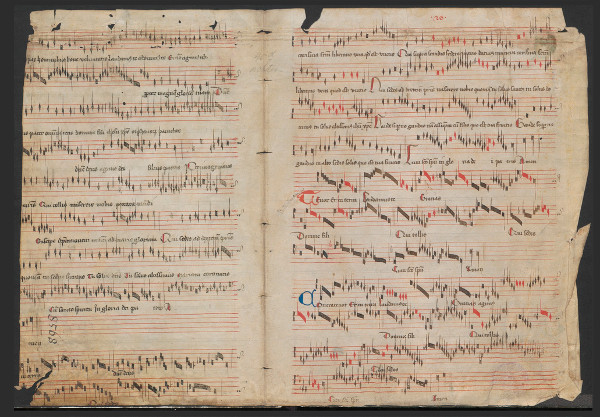
Lute Tablatures
Over its long history a truly enormous repertoire was created for the instrument. American scholar Arthur Ness has estimated that 25,000 pieces survive for the Renaissance lute, and probably as many for the Baroque instruments—and that is only the music specially notated in lute tablature, not counting music from the Medieval and Baroque eras which is written in normal staff notation.Chris Goodwin, "About the Lute," The Lute Society, accessed November 23, 202.
The tablature is a system of notation for early instrumental music (fourteenth–seventeenth century) in which the pitch and duration of a note are not represented by symbols as in staff notation but with a system of letters, figures and certain symbols. One type of symbol in the tablature shows how to produce a sound of the required pitch (which string to pluck, which fret to stop, which key to press etc.) and another to show its duration. While staff notation was primarily developed for single-line music, tablature's specialty is part-music. The most important categories of tablature are those for keyboards (usually the organ) and lute. A large quantity of the keyboard pieces copied between the early fourteenth and sixteenth century (many of them of German origin) survived in tablature form.
In the second half of the fifteenth century three principal systems of lute tablature had been developed: a German, an Italian-Spanish, and a French system. The German system (the earliest known printed in Sebastian Virdung's Musica getutscht, 1511) is probably the oldest. The system's basic principle was to guide the fingers of the player's left hand over the lattice, formed by courses and frets on the fingerboard. At each intersection of a fret and course, a specific note was represented by a letter of the alphabet running across the fingerboard from bottom course to top. For higher frets the alphabet was repeated either in doubled letters or in letters with a dash above them (aa or ā etc.). The symbols intended to be played simultaneously were grouped in vertical columns of two, three or four at a time. Rhythm signs were placed above each note or group of notes. A limitation of lute tablature is its inability to precisely notate the duration of notes played simultaneously, except for the shortest ones.
The various types of lute tablature represent a more direct form of instruction to the player and have been used for virtually all lute music from the early sixteenth century to the present time.
Click here for mp3 theorbo file:
Prelude in e minor (1,30 MB)
Robert de Visée (1650–1725)
Performed by: Yair Avidor
Click here for a MP3 audio-file of:
Canario
Giovanni Girolamo Kapsperger (1580–1651)
from the M.L. Lutebook, 26r,
Performed by: Thomas Bergham
Iconographic Meaning of the Lute
The lute is rich not only in repertoire but in symbolism. Its refined sound has given it courtly associations in East and West. Conversely, it could be an emblem of lust or lasciviousness: in the hands of an older man it symbolized scandal and degeneracy.
If the lute's sensuous and delicate tones evoked the pleasures of love, the fleeting nature of its sound, and the physical fragility of the instrument made it a fitting emblem of transience and death: it is often included, sometimes alongside a skull, in Dutch still life paintings of the Vanitas variety, illustrating the vanity of worldly existence.Chris Goodwin, "About the Lute," The Lute Society, accessed November 23, 2023 .
Click here archlute MP3 audio-file:
Chiaccona in partite variate
Alessandro Piccinini (1566–c.1638), from the book Intavolatura di Liuto, et di Chitarrone, Libro Primo (1623), p. 121.
Performed by: Robert Eklund
Throughout the centuries the lute is one of the most frequently depicted instruments with the largest variety of iconographical interpretation. Numerous illustrations of lutes appear in the emblem-books like Gabriel Rollenhagen (1583–1619)'s Nucleus emblematum (1611), Jacob Cat (1577–1660)'s popular Sinne-en Minnebeelden (1618) or Cesare Ripa (c. 1555–1622)'s Iconologia (1644). The lute, with its ensemble of different pairs of strings, provided a perfect symbol for concord and harmony. The Roman philosopher Boethius associated in his work De institutione musica (c. 500) the thoughts of the ancient natural philosophers Plato and Aristoteles about the harmonious order of the universe or the spheric harmony with the term musica mundana and the harmonious order of the human body and soul with the term "musica humana."Karsten Erik Ose, "Die Frau, das zartbesaitete Wesen. Ikonographie als Sittengeschichte (16.-18. Jahrhundert)," in Ikonographische Zeugnisse zu Musikinstrumenten in Mitteleuropa. 18. Musikinstrumentenbau-Symposium in Michaelstein, 21. bis 23. November 1997, edited by Monika Lustig et al., Michaelsteiner Konferenzberichte 58 (Michaelstein: Kloster Michaelstein Musikakademie, 1997), 112. These concepts were later of eminent significance for Renaissance ideals. Almost all depictions of the"celestial music" show angels playing the lute (fig. 10), as a part of the eternal Soli Deo Gloria, where it stands for the proclamation of "piece on earth and good will to all men" – the new won harmony (reconciliation) between God and mankind as the highest expression of the sacred love.
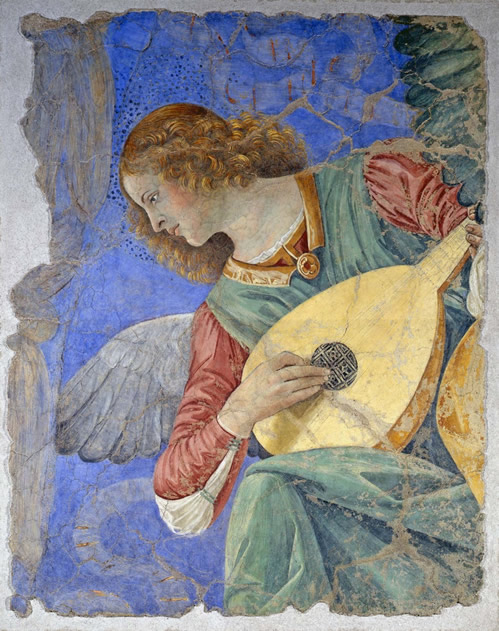
c. 1480
Melozzo da Forli
| (fresco-fragment),
Rome, St. Peter's Cathedral.
With the new humanistic ideals of the Renaissance and their further development in the following centuries, the church gradually lost its privilege in the area of the arts. Paintings showed no longer only religious or mythological scenes but an increasing number of portrayals of the daily life—so-called "genre scenes" which enjoyed great popularity particularly in the arising class of the wealthy burghers in the seventeenth century. Many "Merry musical companies," which clearly displayed amorous intentions, were specially attractive for younger people. The lute with its soft seductive sound was the perfect accompaniment to love songs in numerous new songbooks. That explains why the lute is the preferred musical instrument in so many "brothel scenes," like Dirck van Baburen's Procuress (fig. 11).
Vermeer quoted Baburen's painting (which was very likely owned by his mother-in-law Maria Thins) twice, in The Concert (c. 1665/66) and in A Lady Seated at a Virginal. The inclusion of Baburen's painting has led to interpretations of amorous intentions of the protagonists of Vermeer's composition, but we have to consider that brothel scenes may sometimes to be understood as the "Parable of the Prodigal Son." Therefore, they should serve as a warning not to lose one's money (and good reputation) in such housesNorbert Schneider, Vermeer, (Köln, London: TASCHEN, 2004), 23–24. and consequentially as an encouragement for temperance in the daily life.
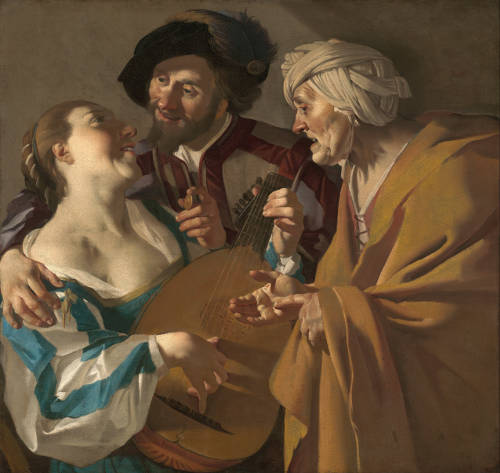
Dirck van Baburen
c. 1622
Oil on canvas, 101.6 x 107.6 cm.
Museum of Fine Arts, Boston
Last but not least, the lute could symbolize the concord and harmony in matrimony and family made evident by numerous family portraits with musical instruments. The Portrait of the Family (fig. 12) Van Berchem by the Flemish master Frans Floris (1561) demonstrates this concord and harmony in double sense: both husband and wife play an instrument (lute and a polygon spinet) with pairs of strings which stand for two different people "tuning" their hearts to an harmonious "sound" (life) like the strings should be well tuned to produce harmonious chords.
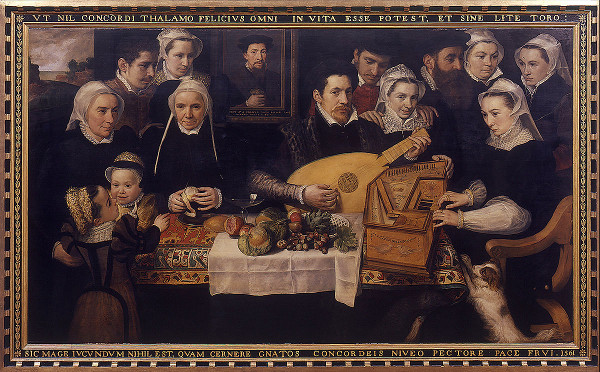
Frans Floris
1561
Oak on panel, 130 x 225 cm.
Stedelijk Museum Wuyts-Van Campen en Baron Caroly
This concept was praised in a moving poem by Constantijn Huygens, private secretary to two Dutch Stadtholders and perhaps the most prominent figure in the Dutch musical life of his time: Twee ongepaerde handen op een clavecymbel ("Two unpaired hands on a harpsichord"), dated 23 February, 1648, with the conclusion that [two concordant souls] "in a heavenly way will give birth to a joy, a delight, only known by few who carry flesh and bones. It is part of angels' singing." Commenting on this poem the musicologist Frits Noske wrote: "Concord (eendracht) between husband and wife is described here not as serene co-ordination or fusion but as a bond of two unequal, though equivalent, individuals…"Frits Noske, Music Bridging Divided Religions. The Motet in the Seventeenth-Century Dutch Republic, Vol. I (Wilhelmshaven: Florian Noetzel Verlag, 1989), 29; and in "Two unpaired hands holding a music sheet. A recently discovered portrait of Constantijn Huygens and Susanna van Baerle," Tijdschrift van de Vereniging voor Nederlandse Muziekgeschiedenis XLII-1 (1992): 135.
Constantijn Huygens: A poem to the lute
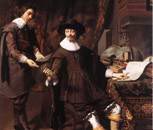
Constantijn Huygens and his Clerk (detail)
Thomas de Keyser
1627, National Gallery London
Luit, getuige van mijn tranen,
Luit, getuige van mijn vreugd,
Van mijn' onbevlekte jeugd:
Luit, toekomende verblijden,
(Als 't het de Hemel wel mag lijden)
Van mijn' dorren ouderdom
Luit, mijn' stille Treves-trom [treves: 12-jarig bestand]
Luit, mijn' fluit, mijn dove trompen,
Luit, mijn' feest mijn' druiven-dompen,
Luit, mijn heus onnozel spel,
Mijn vermakelijk gekwel.
(Iets boertigs, regel 6-16)
Engl.:
Lute, bear witness to my tears,
Lute, bear witness to my joy,
Of my untarnished youth:
Lute, future enjoyments,
(If heaven will suffer this)
Of my arid old age,
Lute, my silent Treves drum, [Treves: 12-year armistice]
Lute, my flute, my deaf muzzles
Lute, my party, my grape-bruising,
Lute, my genuinely witless play,
My amusing warbling
(Something Farcical, lines 6–16)
The Lute on the Web:
- The Lute Page
http://www.cs.dartmouth.edu/~wbc/lute/lute.html - The Lute Society of America
https://lutesocietyofamerica.org/ - The English Lute Society:
http://www.lutesoc.co.uk/ - A Brief History of the Lute by Robert Spencer
http://www.vanedwards.co.uk/history1.htm - Chitarrone, theorbo and Archlute by Robert Spencer
http://www.vanedwards.co.uk/spencer/html/spencer.htm - The Theorbo Information Page compiled by Lynda Sayce
http://www.theorbo.com/theorboinformation/theorboinformation.html - A Historic Lute (Padua or Venice, c.1600) from the National Music Museum at the University of South Dakota
Lute Resources:
- Grove Music Online:
http://www.grovemusic.com - entry 'Lute': Ian Harwood; Diana Poulton/David van Edwards; Diana Poulton/Tim Crawford.
- entry 'Theorbo': Ian Harwood, Robert Spencer, James Tyler.
- entry 'Archlute': Lynda Sayce.
- see also Robert Spencer, 'Chitarrone, Theorbo and Archlute', in: Early Music vol. 4, October 1976, 407–422.
- entry 'Tablature': Thurston Dart/John Morehen/Richard Rastall
- Das neue Lexikon der Musik, 4 Bände, Stuttgart-Weimar 1996
- Erich Höhne, Musik in der Kunst, Leipzig, 2nd ed. 1973